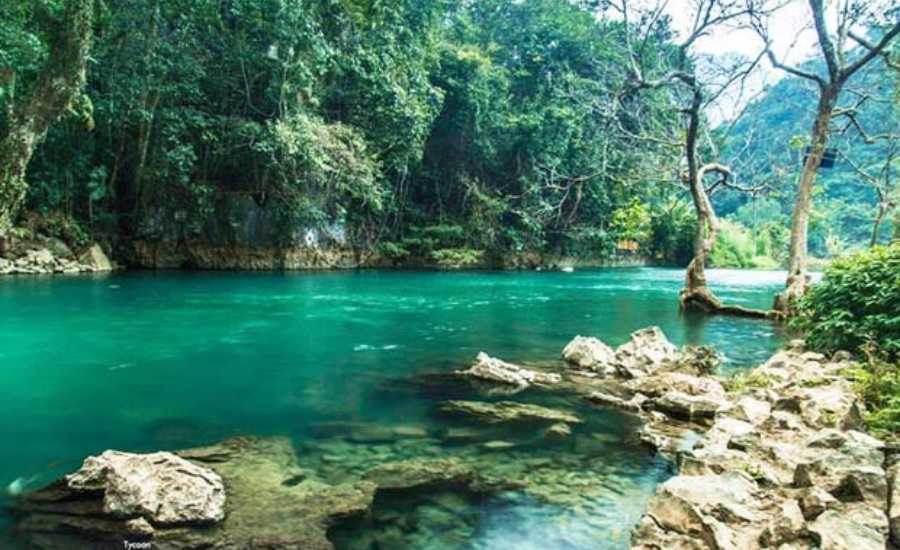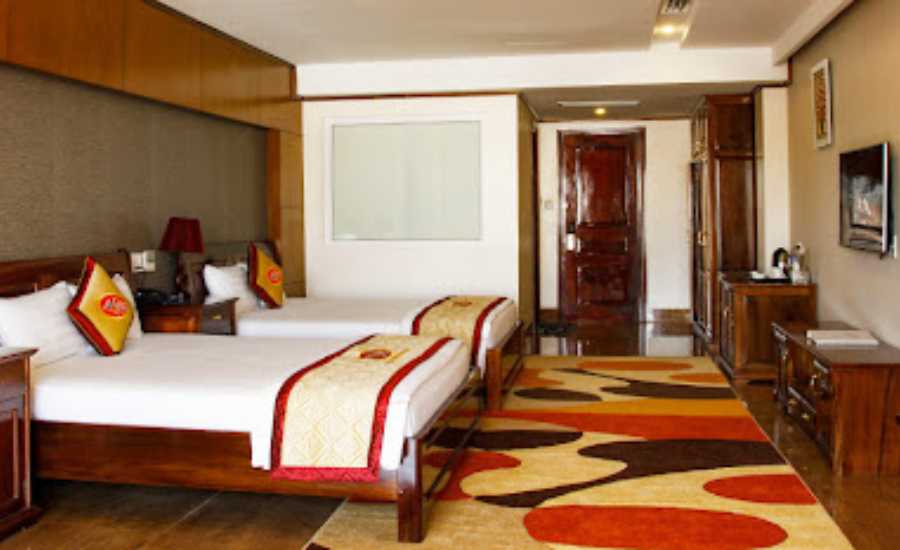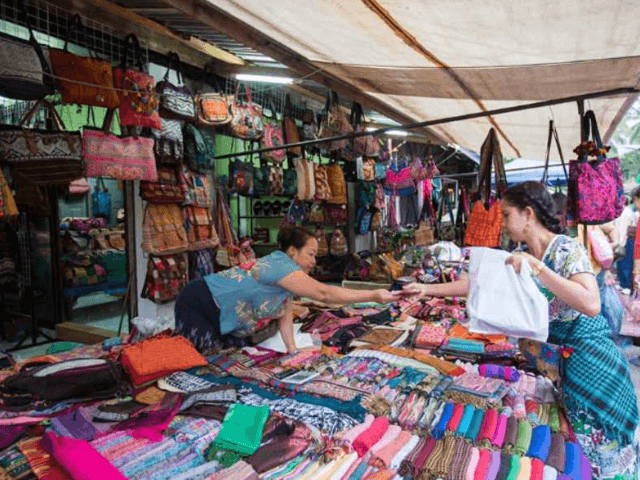Non Nuoc Cao Bang is one of Vietnam’s most remarkable natural and cultural treasures. Located in the northernmost region of the country, it was designated a UNESCO Global Geopark in 2018, making it the second site in Vietnam to receive this prestigious recognition after Dong Van Karst Plateau. The park spans over 3,000 square kilometers, encompassing dramatic karst landscapes, pristine rivers, rich biodiversity, and centuries-old cultural heritage. Whether you're an adventure seeker, a history enthusiast, or someone looking for a tranquil escape into nature, Non Nuoc Cao Bang offers an unmatched blend of geological wonder and cultural depth.
TABLE OF CONTENTS
1
Introduction to Non Nuoc Cao Bang Geopark
What Makes Non Nuoc Cao Bang a UNESCO Global Geopark?
Exceptional Geological Value
Unique Biodiversity
Rich Cultural and Historical Heritage
The Geological & Cultural Significance of Cao Bang
Why You Should Visit This Natural Wonder
2
3
How to Get to Non Nuoc Cao Bang
Best Routes from Hanoi and Other Major Cities
Transportation Options - Bus, Motorbike, or Private Car
Top Attractions in Non Nuoc Cao Bang
Ban Gioc Waterfall - Vietnam’s Largest & Most Stunning Waterfall
Nguom Ngao Cave - A Hidden Underground Wonder
Phia Oac - Phia Den National Park - A Biodiversity Hotspot
Thang Hen Lake - A Mysterious Seasonal Lake System
Pac Bo Historical Site - The Legendary Ho Chi Minh Cave
4
Best Things to Do in Non Nuoc Cao Bang Geopark
Exploring Karst Landscapes & Unique Rock Formations
Trekking & Hiking in Cao Bang’s Majestic Mountains
Cycling and Motorbiking Through Scenic Routes
Visiting Ethnic Villages & Experiencing Local Culture
Trying Local Cuisine - What to Eat in Cao Bang
5
Where to Stay in Cao Bang
Transportation Options from Hanoi to Cao Bang
Best Hotels & Resorts for a Comfortable Stay
Homestays & Guesthouses for an Authentic Experience
Eco-Lodges for Nature Enthusiasts
6
Essential Travel Tips for Non Nuoc Cao Bang
What to Pack for Your Trip
Safety Tips for Exploring Remote Areas
Local Customs and Responsible Tourism Guidelines
7
Conclusion - Why Non Nuoc Cao Bang Should Be on Your Vietnam Bucket Listst
Final Travel Tips for an Unforgettable Visit
How to Make the Most of Your Cao Bang Adventure
Introduction to Non Nuoc Cao Bang Geopark
What Makes Non Nuoc Cao Bang a UNESCO Global Geopark?
Non Nuoc Cao Bang’s recognition as a UNESCO Global Geopark is not accidental - it reflects the site’s extraordinary geological, ecological, and cultural significance. The park is a living testament to Earth’s ancient history, with landscapes and formations that tell a story dating back over 500 million years.
Exceptional Geological Value
Non Nuoc Cao Bang holds geological evidence that spans half a billion years, making it a crucial site for understanding Earth's history. It showcases remnants of ancient oceans, tectonic shifts, volcanic activity, and even glacial periods. The karst formations, which are some of the oldest in Southeast Asia, feature unique rock structures, underground rivers, and fossilized coral reefs. The park’s sedimentary rocks and fossils provide valuable insights into the Earth's evolutionary processes, giving scientists a window into past marine and terrestrial life.
Unique Biodiversity
The park’s diverse terrain - from lush forests and limestone cliffs to rivers and caves - creates a rich habitat for a wide range of species. It is home to numerous rare and endangered plants and animals, including the Tonkin snub-nosed monkey and several species of orchids and ferns. The biodiversity within Phia Oac - Phia Den National Park, part of Non Nuoc Cao Bang, adds to the ecological significance of the region. Visitors can explore a variety of ecosystems, from tropical rainforests to alpine meadows, each supporting unique wildlife.
Rich Cultural and Historical Heritage
Non Nuoc Cao Bang is not only a geological treasure but also a cultural and historical landmark. It is home to nine ethnic minority groups, including the Tay, Nung, H’mong, and Dao, who have preserved their traditional languages, customs, and crafts for centuries. The park also holds historical importance as the place where Ho Chi Minh returned in 1941 to launch Vietnam’s independence movement. Traditional stilt houses, vibrant rice terraces, and ancient temples reflect the deep connection between the local people and their natural environment.
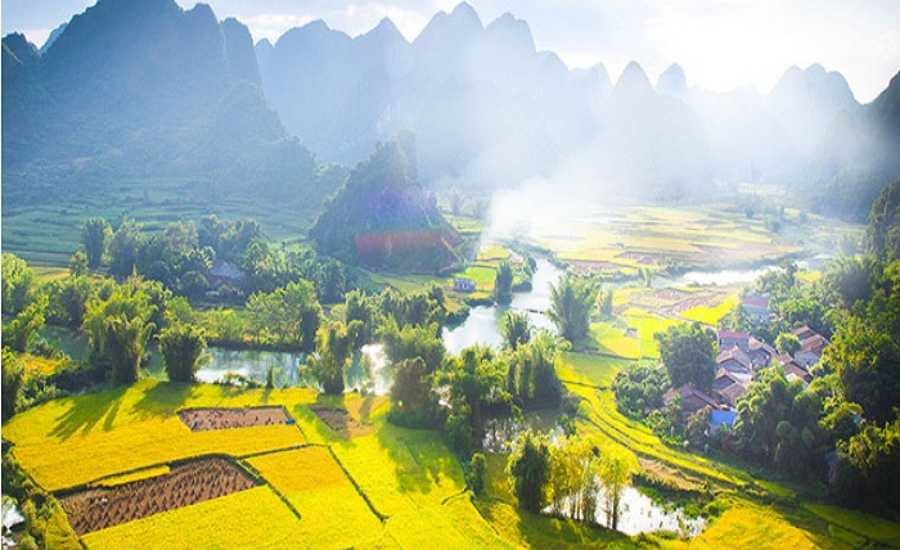
The Geological & Cultural Significance of Cao Bang
Cao Bang’s geological story is a complex and fascinating one that dates back over 500 million years. At that time, the region was submerged under a shallow tropical sea where the deposition of marine sediments gradually formed limestone. Over millions of years, volcanic eruptions, tectonic collisions, and erosion reshaped the landscape into the karst formations and river valleys visible today.
Geologists have divided the park into three distinct geological zones:
- Western Zone - Characterized by ancient volcanic rocks and rich fossil deposits, this area provides key insights into early Earth’s geological activity.
- Central Zone - Home to towering limestone karsts, underground caves, and underground rivers, this area showcases classic karst topography formed through millions of years of erosion and tectonic activity.
- Eastern Zone - Defined by younger sedimentary rocks and dramatic river valleys, this area reveals the more recent geological evolution of the region.
On the cultural side, Cao Bang has been inhabited for centuries by ethnic minorities who have developed unique traditions and ways of life. Visitors can witness traditional weaving, wood carving, and agricultural practices passed down through generations. Historical sites such as Pac Bo Cave and Lenin Stream, where Ho Chi Minh sought refuge during the independence movement, serve as powerful reminders of Vietnam’s revolutionary past.
Why You Should Visit This Natural Wonder
Non Nuoc Cao Bang stands out as one of the most beautiful and culturally rich destinations in Vietnam. It offers a rare combination of natural splendor and historical depth, making it ideal for travelers seeking both adventure and cultural immersion.
- Spectacular Natural Scenery - From the majestic Ban Gioc Waterfall to the serene Thang Hen Lake, the park’s diverse landscapes provide breathtaking views and countless photo opportunities.
- Adventure and Exploration - Whether you prefer hiking through limestone mountains, exploring hidden caves, or motorbiking along winding mountain roads, Non Nuoc Cao Bang has no shortage of outdoor activities.
- Cultural Immersion - Meeting the local ethnic communities and experiencing their traditional music, food, and crafts offers a deeper connection to Vietnam’s rich cultural heritage.
How to Get to Non Nuoc Cao Bang
Best Routes from Hanoi and Other Major Cities
Non Nuoc Cao Bang is located approximately 280 kilometers (174 miles) from Hanoi, making it accessible by road. The journey itself is scenic, taking you through winding mountain passes, lush valleys, and rural villages.
- From Hanoi - The most direct route is via National Highway 3, which takes around 6 to 8 hours depending on traffic and road conditions.
- From Ha Giang - The distance is about 240 kilometers (149 miles), and the drive takes around 7 hours through winding mountain roads.
- From Lang Son - This is a shorter route of about 130 kilometers (81 miles), taking around 4 hours.
Transportation Options - Bus, Motorbike, or Private Car
-
Bus - Several direct buses operate between Hanoi and Cao Bang City, departing from My Dinh Bus Station. The journey costs around 250,000-350,000 VND ($10-15 USD) and takes approximately 6-7 hours.
-
Motorbike - For those seeking adventure, traveling by motorbike offers greater flexibility to explore off-the-beaten-path locations. However, the roads can be steep and challenging, so experience in mountain riding is recommended.
-
Private Car - Hiring a private car or a driver is the most comfortable and convenient option, especially for groups or families. A private car from Hanoi costs around 2,500,000 VND ($100 USD) per day.
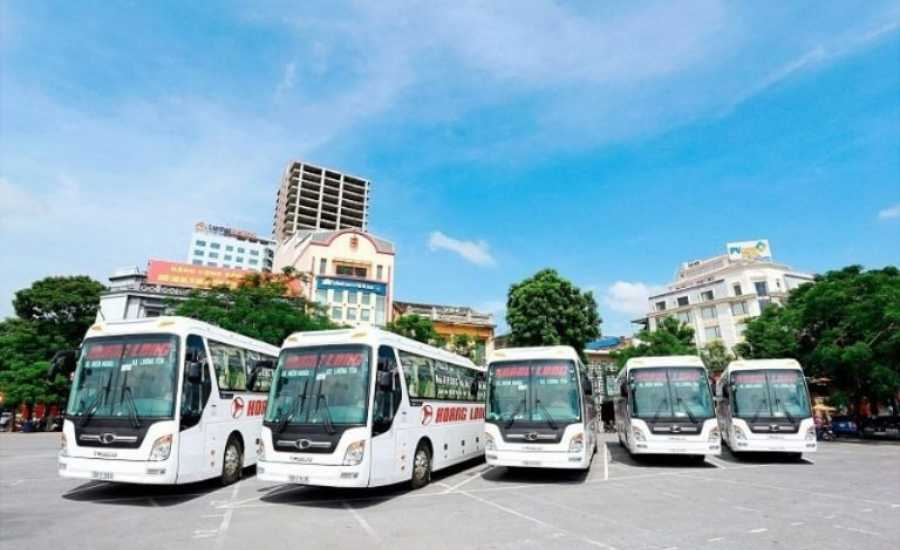
Best Time to Visit for Ideal Weather & Sightseeing
Non Nuoc Cao Bang experiences distinct seasons, each offering unique scenery and travel experiences:
- Spring (March to May) - Mild weather and blooming flowers make this an ideal time for sightseeing and outdoor activities.
- Summer (June to August) - Ban Gioc Waterfall reaches its peak flow, creating a spectacular sight. However, the weather can be hot and humid.
- Autumn (September to November) - Cool temperatures and golden rice terraces create a stunning backdrop for hiking and photography.
- Winter (December to February) - Cold weather brings misty valleys and frost-covered peaks, adding a mystical atmosphere to the park.

Top Attractions in Non Nuoc Cao Bang
Ban Gioc Waterfall - Vietnam’s Largest & Most Stunning Waterfall
Ban Gioc Waterfall is undoubtedly the crown jewel of Non Nuoc Cao Bang and one of the most iconic natural landmarks in Vietnam. Situated on the Quay Son River, Ban Gioc straddles the border between Vietnam and China, creating a breathtaking natural boundary.
Ban Gioc stands at 30 meters high and stretches over 300 meters wide, making it the largest waterfall in Vietnam and the fourth largest cross-border waterfall in the world. The waterfall is divided into multiple tiers, with powerful cascades plunging into a jade-green pool below, surrounded by lush green rice paddies and limestone cliffs.
During the rainy season (June to September), the waterfall reaches its most dramatic state, with a thunderous flow and mist rising into the air, creating rainbows in the sunlight. In the dry season (October to May), the flow becomes gentler, revealing intricate rock formations beneath the water.
You can take a bamboo raft ride to get close to the base of the waterfall for about 50,000 VND per person. From this vantage point, you’ll feel the refreshing mist on your face and hear the powerful roar of the falls. The surrounding area is also dotted with charming villages and rice fields, adding to the picturesque setting.
.jpg)
Nguom Ngao Cave - A Hidden Underground Wonder
Just a short drive from Ban Gioc Waterfall lies Nguom Ngao Cave, a spectacular limestone cave known for its extensive network of tunnels and magnificent stalactites and stalagmites. The cave was formed millions of years ago through the erosion of underground rivers, creating fascinating formations that resemble natural sculptures.
Nguom Ngao Cave stretches for over 2 kilometers, though only around 1 kilometer is open to the public. As you enter, you’ll be greeted by cool air and the soft sound of dripping water. Inside, the cave is illuminated by strategic lighting that highlights the unique shapes and textures of the formations.
Some of the most famous formations include:
- Silver Tree - A towering white stalactite that sparkles under the light.
- Lion's Head - A naturally formed rock that resembles a lion's head.
- Fairy’s Room - A chamber with delicate, thin stalactites hanging from the ceiling.
Exploring Nguom Ngao Cave feels like stepping into another world, with the cool temperature and ethereal atmosphere making it a peaceful retreat from the outside heat. The entrance fee is around 40,000 VND per person.
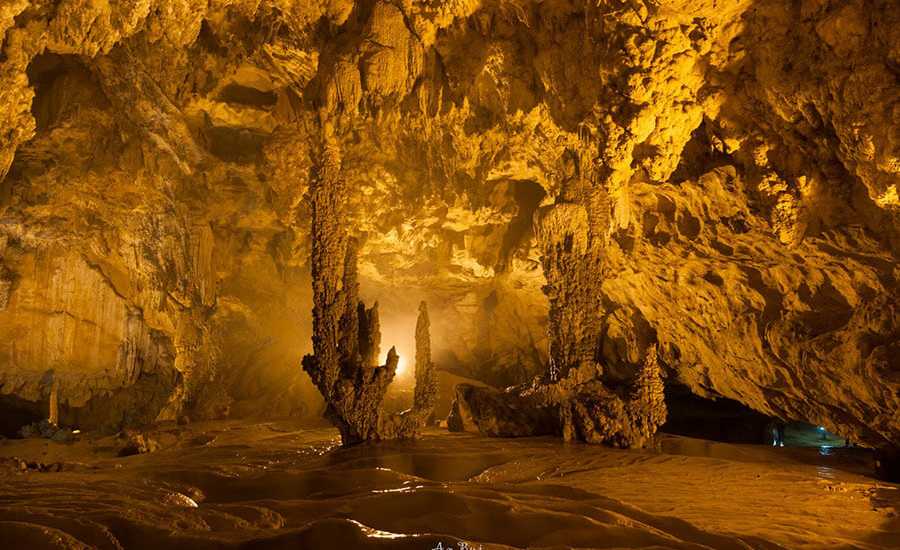
Phia Oac - Phia Den National Park - A Biodiversity Hotspot
Phia Oac - Phia Den National Park is a paradise for nature lovers and adventure seekers. Located at an altitude of 1,500 - 2,000 meters above sea level, the park offers a cool and refreshing climate, even during the hot summer months.
The park is home to a diverse range of flora and fauna, including over 1,000 plant species and numerous rare animals such as the Tonkin snub-nosed monkey and Asian black bear. The high altitude and rich soil create a unique ecosystem where moss, ferns, and ancient trees thrive.
Popular activities in Phia Oac - Phia Den National Park include:
- Trekking: Several trails of varying difficulty levels lead through the forest and up to panoramic viewpoints.
- Birdwatching: The park is home to over 200 species of birds, making it a prime spot for bird enthusiasts.
- Camping: There are designated camping spots where you can sleep under the stars surrounded by nature.
During winter (December to February), the park occasionally experiences frost and even snowfall, creating a magical winter landscape rarely seen in Vietnam.
Thang Hen Lake - A Mysterious Seasonal Lake System
Thang Hen Lake is part of a system of 36 interconnected lakes located high in the mountains of Cao Bang. The lake’s water level fluctuates depending on the season, creating a constantly changing landscape.
In the rainy season, the lakes merge into one large body of water surrounded by limestone cliffs and green forests. In the dry season, the water level drops, revealing sandy shores and the rocky lakebed. The deep emerald color of the lake reflects the surrounding karst formations, creating a tranquil and picturesque scene.
Visitors can rent small wooden boats to explore the lake or walk along the shoreline to enjoy the peaceful atmosphere. Thang Hen Lake is also surrounded by ethnic Tay villages, where you can experience local culture and cuisine.

Pac Bo Historical Site - The Legendary Ho Chi Minh Cave
Pac Bo is not just a natural landmark; it holds deep historical significance as the site where Ho Chi Minh lived and worked after returning to Vietnam in 1941 to lead the revolutionary movement.
The site includes:
- Lenin Stream: A crystal-clear stream named by Ho Chi Minh after the Russian revolutionary leader.
- Karl Marx Mountain: A limestone peak overlooking the stream.
- Pac Bo Cave: The modest cave where Ho Chi Minh lived and wrote revolutionary strategies.
Walking through Pac Bo feels like stepping back in time. The simple wooden house and cave provide insight into the humble beginnings of Vietnam’s fight for independence. The peaceful natural setting contrasts with the profound historical weight of the site.
Best Things to Do in Non Nuoc Cao Bang Geopark
Exploring Karst Landscapes & Unique Rock Formations
Non Nuoc Cao Bang’s karst landscapes are some of the oldest in Southeast Asia, dating back over 500 million years. The dramatic limestone peaks, deep valleys, and underground rivers create a natural playground for explorers. Popular karst formations to explore include:
- The towering limestone cliffs around Ban Gioc Waterfall.
- The hidden caves and tunnels within Nguom Ngao Cave.
- The karst plateau in Phia Oac - Phia Den National Park.
Trekking & Hiking in Cao Bang’s Majestic Mountains
Trekking is one of the best ways to explore Cao Bang’s natural beauty. The trails vary from easy village walks to challenging mountain hikes. Recommended trails:
- Ban Gioc to Nguom Ngao: A moderate trail through rice fields and karst formations.
- Phia Oac Peak: A challenging but rewarding climb with panoramic views.
Cycling and Motorbiking Through Scenic Routes
Cao Bang’s winding mountain roads offer some of the most scenic cycling and motorbiking routes in Vietnam. The roads are well-maintained, but the steep passes require confidence and experience. Popular routes:
- Hanoi to Cao Bang: 280 km of scenic mountain roads.
- Cao Bang to Ban Gioc: 80 km through limestone peaks and rice terraces.
Visiting Ethnic Villages & Experiencing Local Culture
Cao Bang is home to 9 ethnic minority groups. Visiting local villages gives you a chance to learn about traditional crafts, music, and cuisine. Recommended villages:
- Khuoi Ky Stone Village: Known for its stone houses and traditional weaving. Known for its stone houses and traditional weaving.
- Phuc Sen Village: Famous for blacksmithing.
Trying Local Cuisine - What to Eat in Cao Bang
Cao Bang’s cuisine reflects the influences of its diverse ethnic communities. Must-try dishes include:
- Bánh cuốn Cao Bằng: Steamed rice rolls filled with minced pork and mushrooms, served with dipping sauce.
- Khâu nhục: Braised pork belly with spices.
- Mèn mén: Steamed corn flour served with vegetables.
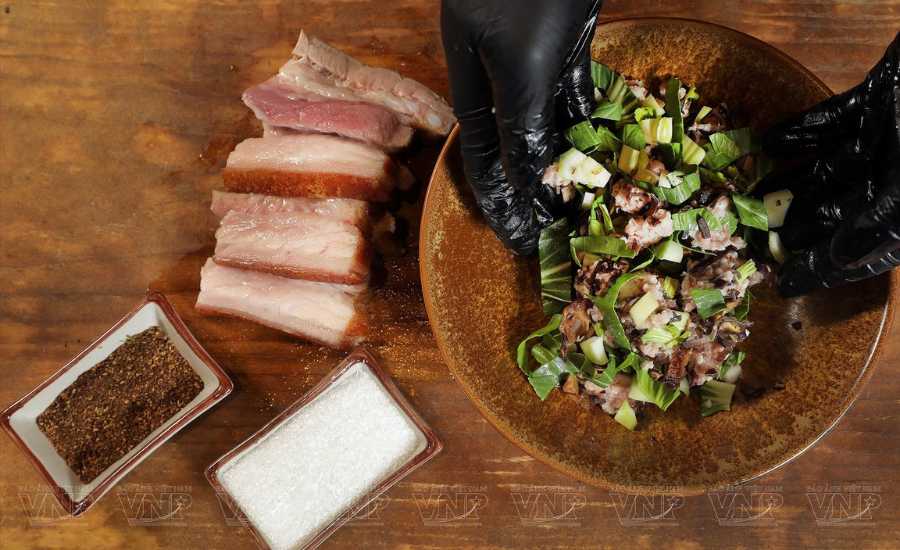
Where to Stay in Cao Bang
Transportation Options from Hanoi to Cao Bang
When planning your trip to Non Nuoc Cao Bang, choosing the right accommodation is essential for a comfortable and memorable experience. Cao Bang offers a wide range of lodging options, from modern hotels to charming homestays and eco-lodges that bring you closer to nature. Depending on your budget and travel style, you can find accommodations that suit your needs while allowing you to experience the local culture and natural beauty of the region.
Best Hotels & Resorts for a Comfortable Stay
If you prefer modern comforts and convenient amenities, staying at a hotel or resort in Cao Bang City is the best option. Most hotels in the city provide easy access to local restaurants, markets, and transportation hubs.
Here are some of the best hotels and resorts in Cao Bang:
Max Boutique Hotel
Located in the heart of Cao Bang City, Max Boutique Hotel offers modern and well-appointed rooms with all the essential amenities, including free Wi-Fi, air conditioning, and a 24-hour front desk. The hotel also has a rooftop bar where you can enjoy panoramic views of the city and surrounding mountains.
Jeanne Hotel
Jeanne Hotel is a luxury hotel known for its elegant design and exceptional service. The rooms are spacious and equipped with high-quality furnishings. The hotel features a spa, a fitness center, and a restaurant serving both Vietnamese and international cuisine.
Sunny Hotel
Sunny Hotel offers a balance of comfort and affordability. The hotel features clean, spacious rooms with comfortable beds and modern decor. Guests can enjoy a buffet breakfast and friendly staff who can help arrange tours to Ban Gioc Waterfall and other attractions.
Hotels in Cao Bang City are ideal for travelers who value convenience and want to have easy access to transportation and local dining options. Booking in advance is recommended, especially during peak travel seasons (September to November and March to May).
Homestays & Guesthouses for an Authentic Experience
For travelers looking to immerse themselves in the local culture, staying at a homestay or guest house is a great choice. Homestays are often located in small ethnic villages, allowing you to experience the traditional way of life, enjoy home-cooked meals, and interact with local hosts. Here are some recommended homestays and guesthouses in Cao Bang:
Khuoi Ky Homestay
Khuoi Ky is a traditional Tay ethnic village where most of the houses are made of stone. Staying at Khuoi Ky Homestay gives you the chance to experience life in a Tay village, enjoy meals cooked over an open fire, and learn about the locals' weaving and farming practices.
Primrose Homestay
Primrose Homestay is a cozy family-run guesthouse in Cao Bang City. The hosts are incredibly welcoming and can help you arrange tours and transportation. The homestay offers both private and dorm-style rooms, making it suitable for solo travelers and groups.
Lo Lo Homestay
Located in a Lo Lo ethnic village near Ban Gioc Waterfall, this homestay is made of wood and bamboo, giving it a rustic charm. Guests can join the host family in preparing traditional dishes and participate in local festivals if visiting during special occasions.
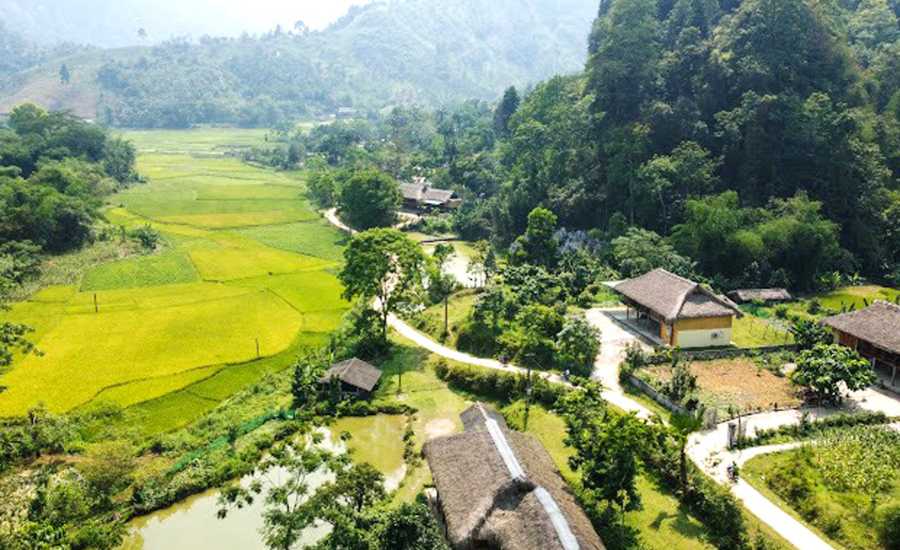
Homestays offer a more personal and meaningful experience compared to hotels. You’ll have the opportunity to connect with locals, learn about their customs, and enjoy authentic meals prepared with fresh, local ingredients.
Eco-Lodges for Nature Enthusiasts
For travelers seeking a deeper connection with nature, eco-lodges provide an ideal balance of comfort and environmental sustainability. These lodges are often located in remote areas surrounded by forests and mountains, providing a peaceful retreat from the busier tourist spots. Some of the best eco-lodges in Cao Bang include:
Phia Thap Eco Lodge
Nestled in a remote mountain village, Phia Thap Eco Lodge is designed to minimize its impact on the environment. The lodge features wooden bungalows with thatched roofs and solar-powered electricity. Guests can join guided nature walks and learn about local herbal medicine.
Cao Bang Eco Homestay
Surrounded by rice paddies and karst mountains, this eco-lodge provides a tranquil escape. The rooms are built using locally sourced materials, and the lodge offers farm-to-table meals made with organic ingredients.
Staying at an eco-lodge allows you to experience the natural beauty of Cao Bang while supporting sustainable tourism practices. These lodges often offer unique activities such as herbal baths, guided forest treks, and cooking classes.
Essential Travel Tips for Non Nuoc Cao Bang
To ensure a smooth and enjoyable trip to Non Nuoc Cao Bang, it’s important to prepare well and be aware of local customs and travel conditions. Here are some essential tips to help you make the most of your adventure:
What to Pack for Your Trip
Cao Bang’s mountainous terrain and varying weather conditions require thoughtful packing. Here’s a checklist of essential items to bring:
- Comfortable walking shoes - Suitable for trekking and uneven terrain
- Waterproof jacket - Cao Bang can experience sudden rain showers, especially in the rainy season
- Warm clothing - Temperatures can drop significantly in the mountains, especially at night
- Sunscreen and insect repellent - Protection from the sun and bugs is essential
- Power bank - Electricity can be unreliable in remote areas
- Cash - ATMs are limited outside Cao Bang City, and many villages only accept cash
Safety Tips for Exploring Remote Areas
Cao Bang’s natural beauty comes with some potential risks, so it’s important to stay cautious:
- Travel with a guide if you’re exploring remote trails or caves
- Inform your host or hotel staff about your travel plans
- Avoid hiking or driving at night due to limited visibility and steep roads
- Stay hydrated and carry snacks, especially if trekking for long distances
Local Customs and Responsible Tourism Guidelines
Cao Bang is home to many ethnic minority communities with distinct traditions and customs. Being respectful of local culture is essential to creating a positive connection with the local people:
- Dress modestly when visiting villages and religious sites
- Ask for permission before taking photos of local people
- Don’t give money or gifts to children to avoid encouraging dependency
- Buy local handicrafts directly from artisans to support the community
- Minimize waste by bringing a reusable water bottle and shopping bag
Practicing responsible tourism helps preserve Cao Bang’s natural and cultural heritage while ensuring that your visit has a positive impact on the local community.
Following these tips will help you navigate Cao Bang smoothly, stay safe, and build meaningful connections with the local people. Proper preparation ensures that you’ll have an unforgettable and enriching experience exploring one of Vietnam’s most spectacular natural wonders.
Conclusion - Why Non Nuoc Cao Bang Should Be on Your Vietnam Bucket Listst
Non Nuoc Cao Bang is more than just a natural wonder-it's a harmonious blend of breathtaking landscapes, rich history, and vibrant cultural traditions. From the majestic Ban Gioc Waterfall and the hidden depths of Nguom Ngao Cave to the tranquil beauty of Thang Hen Lake and the historical significance of Pac Bo, Cao Bang offers a diverse range of experiences that captivate both nature lovers and history enthusiasts alike. The geopark's karst landscapes, ancient rock formations, and unique biodiversity make it one of the most geologically and culturally significant destinations in Vietnam.
But what truly sets Cao Bang apart is the warmth and authenticity of its people. Staying in local homestays, joining in traditional village life, and tasting regional specialties allow visitors to connect deeply with the local culture. The combination of natural beauty and human connection creates a travel experience that goes beyond sightseeing-it becomes a personal journey of discovery and appreciation.
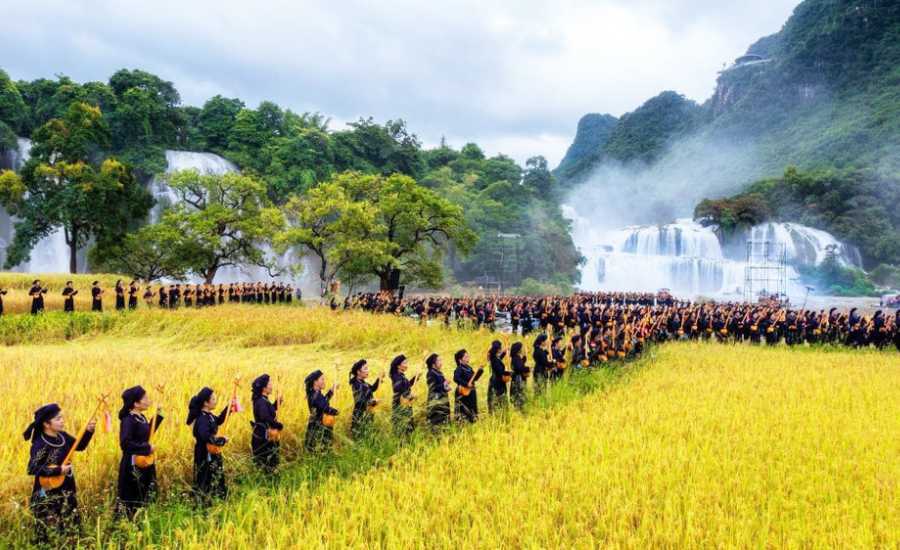
Final Travel Tips for an Unforgettable Visit
To make the most of your trip to Cao Bang, plan ahead and consider the best time to visit, especially during the dry season from September to November when the weather is most favorable. Pack appropriately for the mountainous terrain and unpredictable weather, and always keep safety in mind when exploring remote areas. Booking accommodations in advance, especially for homestays and eco-lodges, ensures a smooth and stress-free trip.
How to Make the Most of Your Cao Bang Adventure
To fully immerse yourself in the Cao Bang experience, take the time to slow down and appreciate the details. Explore the karst mountains on foot or by motorbike, engage with local villagers to learn about their customs and traditions, and savor the flavors of Cao Bang’s unique cuisine. Don't rush through the attractions—let the peaceful rhythm of the countryside and the majestic beauty of nature guide your journey.
If you're planning a Vietnam tour, Cao Bang is a must-visit stop. Non Nuoc Cao Bang is not just a destination—it’s an experience that stays with you long after you leave. Its unspoiled landscapes, rich heritage, and warm-hearted people make it one of Vietnam's most captivating travel destinations. Whether you’re seeking adventure, cultural connection, or a quiet retreat into nature, Cao Bang offers it all.








